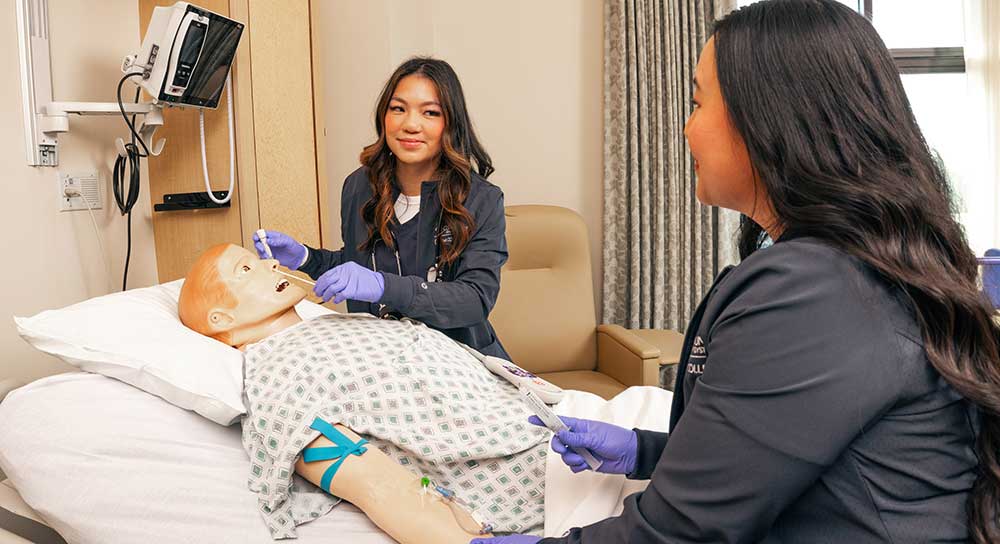David Wolrath didn’t think he’d become a trendsetter in his mid-70s. But the retired teacher and musician is the first person in the Central Valley to undergo Transcarotid Artery Revascularization, a revolutionary procedure that’s changing how doctors treat patients at risk for stroke. Community Regional Medical Center is the first hospital in the region to provide this expertise.
Carotid artery disease often doesn’t produce signs
Wolrath was on a trip to Los Angeles over a year ago when something odd happened. “I got out of bed, put my foot on the floor, and the left leg goes out from under me. I stumble off to the left.”
Wolrath drove back to Fresno, but was so unusually tired he had to stop on the way home to sleep. When he got home, he staggered in through the door, and his wife immediately knew something was wrong. She called her sister, a nurse, who insisted he seek medical help right away.
It turns out, he’d suffered a minor stroke. “I've been blessed all my life,” Wolrath says. “My health has been amazing — no issues. I was quite surprised I had this carotid artery problem.”
Carotid arteries carry blood to the brain, but can also carry plaque
Wolrath was referred to Dr. Kamell Eckroth-Bernard, a vascular surgeon and associate professor at UCSF Fresno. Dr. Bernard says Wolrath had stenosis, or narrowing, of his right carotid artery, and that’s what led to the stroke.
The carotid artery is a major blood vessel that serves your head and brain. As it comes up into the neck, it splits into two, continuing up the left and right sides.
It’s at this split where plaque, a collection of fatty deposits, tends to collect. As more and more plaque builds up, the carotid artery gets narrower, preventing essential oxygen from getting to your brain. Also, pieces of plaque can become dislodged and make their way to the brain.
Dr. Bernard describes it as like putting a thumb over the nozzle of a garden hose to create a more forceful stream:
“So you have your pump here, in the heart. You have a pressure head basically behind the blood flow, and as it's coming up to these narrow areas, instead of it being smooth flow … it's going to be haphazard and fast, and that can lift up pieces of plaque and [send them] to your brain. That's how you get a stroke.”
Stenting in older patients carries a higher risk of stroke
Because he’d already had a stroke, it was important the plaque in Wolrath’s carotid artery be removed in a procedure called a carotid endarterectomy. After the surgery, Dr. Bernard did a check-up on Wolrath and found he’d developed scar tissue in the artery — something that occurs in only 1% of patients.
The buildup of scar tissue had led to restenosis — or re-narrowing — of the carotid artery. This put Wolrath in danger of experiencing another stroke, possibly a major one this time.
Since the first carotid endarterectomy had produced such severe scar tissue, it was likely to do so again. Dr. Bernard decided to put in a carotid stent, or mesh coil, that would essentially “prop open” the artery and prevent it from narrowing. But putting in a stent carried the risk of accidentally dislodging plaque and sending it to Wolrath’s brain.
“It was initially thought that stenting would be better for patients who are a little bit older,” says Dr. Bernard, “but actually what the data shows is that patients who are older tend to not do as well from stents, because their stroke risk is higher. So we chose to do a TCAR for him.”
Community Regional is the only hospital in Fresno County to do TCAR
Transcarotid Artery Revascularization (TCAR) is a blood flow reversal system that allows a stent to be placed in a patient’s carotid artery while lowering the risk of dislodging plaque and causing a stroke.
In a TCAR, a small incision is made in the neck. Blood that flows through the carotid artery is temporarily rerouted to a vein in the leg through an external circuit, or catheter tubing, that removes the blood, pumps and filters it, removing plaque and debris. As this happens, balloons are inserted using another catheter to enlarge the carotid artery, and a stent is placed.
The TCAR procedure itself lasts about 10 minutes.
“Flow reversal in the brain on that side for a short period of time is usually very well tolerated by patients,” says Dr. Bernard. “It allows us to balloon very aggressively in the areas that are narrow and also place our stent, all while allowing flow reversal to happen and protecting the brain at the same time.”
Age and lifestyle risk factors for carotid artery disease
What makes a patient an attractive candidate for a TCAR is the extent of their carotid artery disease, age and risk for stroke.
There are a number of factors that increase risk of developing carotid artery disease, including:
Age
Obesity
Diabetes
Tobacco use
Lack of exercise
High blood pressure
Family history
Carotid artery disease develops slowly and often without signs or symptoms. The first sign you have the disease could be a stroke.
TCAR offers more options to patients
Though he was the first in the Central Valley to undergo a TCAR, Wolrath’s faith in Dr. Bernard and the procedure never wavered.
“I had no idea what Dr. Bernard’s expertise was in terms of new devices and all that sort of thing,” he says. “I had confidence in the man … He had confidence in it, and that was my impetus for continuing.”
Dr. Bernard says that Wolrath’s prognosis is good, and that he’s excited for more patients to have this new technology.
“As patients start to get a little bit older, carotid surgery, you know, it's a gold standard. We do a lot of it here. But now they have another option, and that's what I'm more excited about than anything else.”






